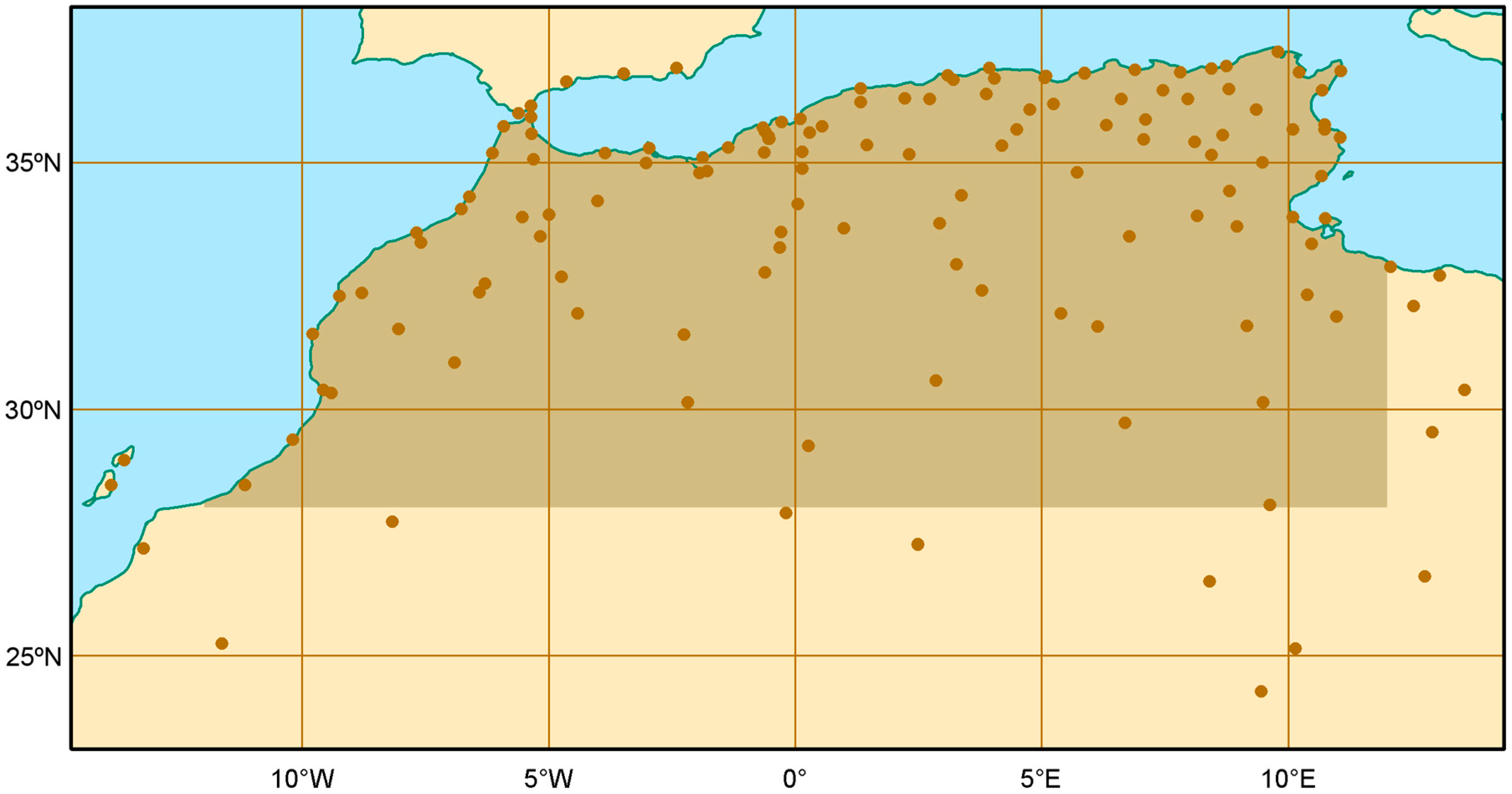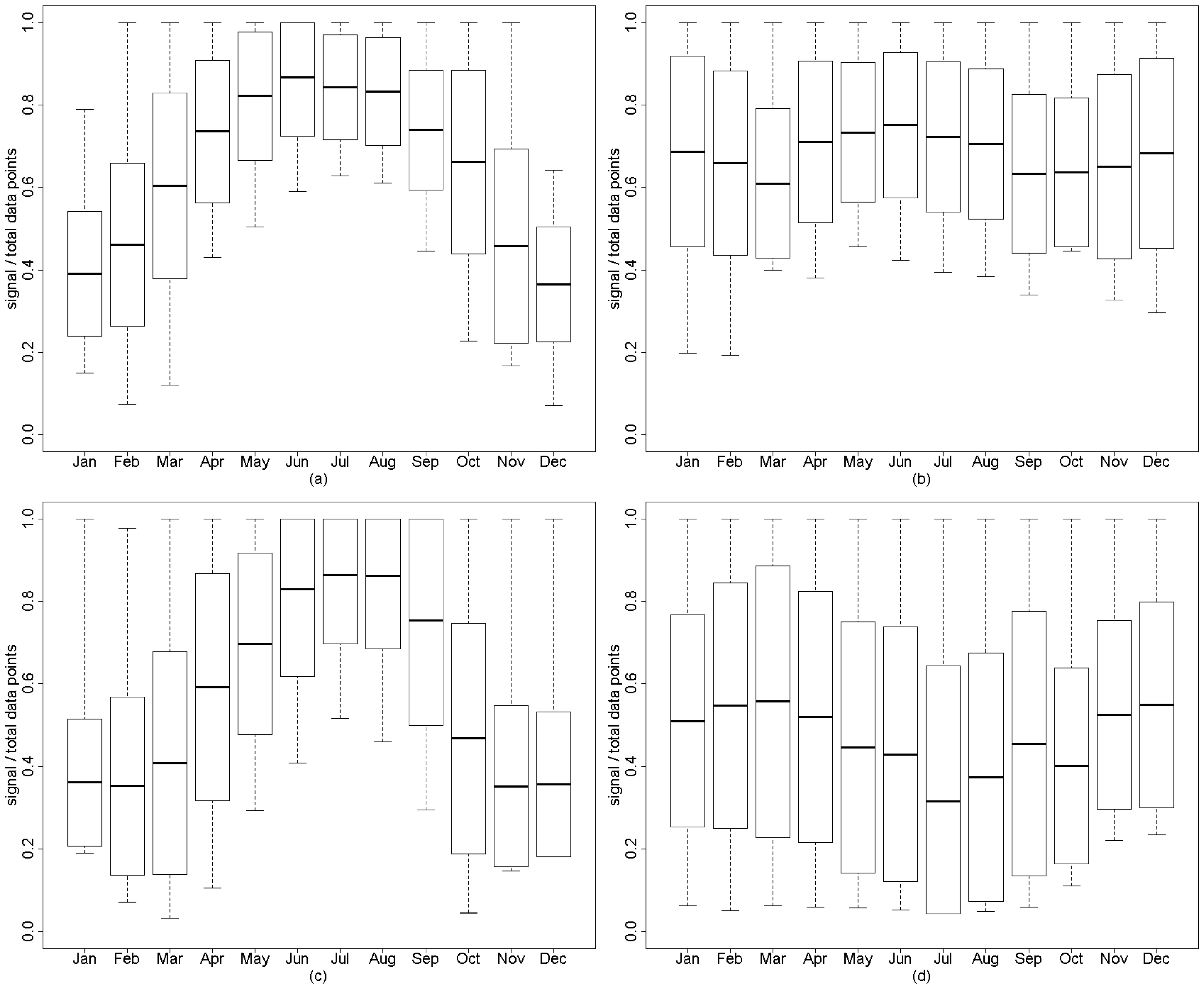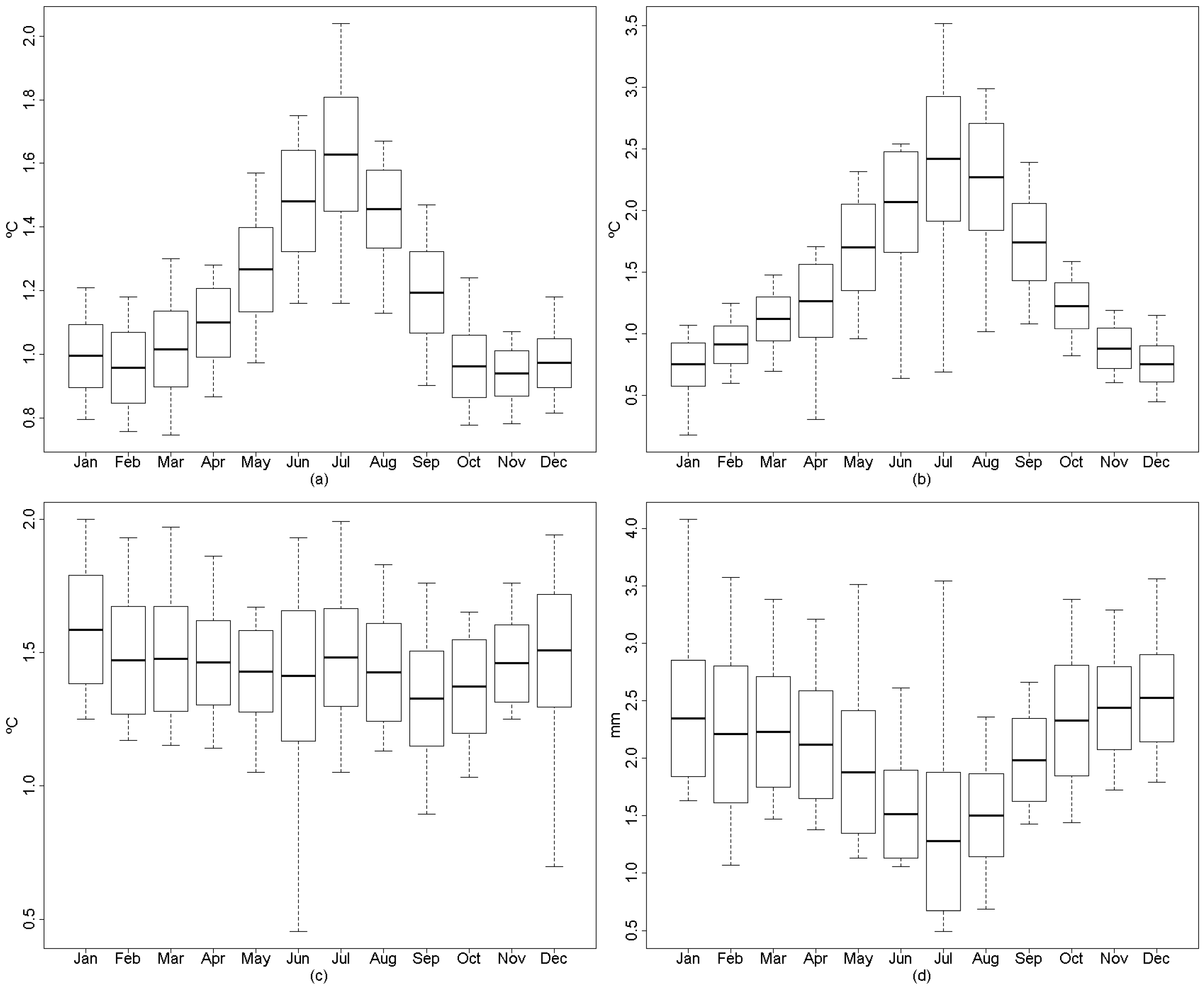A 1973–2008 Archive of Climate Surfaces for NW Maghreb
Abstract
:1. Summary
2. Data Description
2.1. Data
- Mean maximum temperature (°C): arithmetic mean of the daily maximum temperatures (tmax)
- Mean minimum temperature (°C): arithmetic mean of the daily minimum temperatures (tmin)
- Mean temperature (°C): arithmetic mean of the daily mean temperatures (tmed)
- Total precipitation (mm): sum of the daily precipitations (rain)
2.2. Metadata
2.3. Dataset
- Characters 1–4: variable name (tmax, tmin, tmed or rain)
- Characters 5–8: year (1973 to 2008)
- Characters 9–10: month (01 to 12)
3. Methods
4. User Notes
- petHgsm to compute one layer of Potential Evapotranspiration (PET) from tmax, tmed, tmin and extraterrestrial solar radiation layers (internally computed) using the Hargreaves-Samani method [19]. The sister function batchpetHgsm does the same, but for a specified sequence of layers.
- aiObsMe to compute the FAO-UNEP aridity index as the precipitation ratio to PET for a sequence of layers.
- rgf.summary to query a sequence of layers and save the resulting summary in a new layer. This summary refers to the population of each grid cell in the specified sequence. Choices are sum, maximum, minimum, mean, count, range, standard deviation, variance and median. The length of the sequences is controlled by the argument step.
Acknowledgments
Author Contributions
Conflicts of Interest
Abbreviations
| EPSG | European Petroleum Survey Group |
| FAO | Food and Agriculture Organization of the United Nations |
| GCV | Generalized Cross Validation error |
| GCOS | Global Climate Observing System |
| GHCN-Monthly | Global Historical Climatology Network-Monthly |
| GSOD | Global Surface Summary of the Day |
| NCEI | National Centers for Environmental Information |
| netCDF | Network Common Data Form |
| NPP | Net Primary Productivity |
| PET | Potential Evapotranspiration |
| RTGCV | Square Root of GCV |
| UNCCD | United Nations Convention to Combat Desertification |
| UNEP | United Nations Environment Program |
| WMO | World Meteorological Organization |
References
- NCEI. Global Surface Summary of Day, Version 7. National Centers for Environmental Information, NESDIS, NOAA, US Department of Commerce: Asheville, NC, 2016. [Google Scholar]
- Hijmans, R.J.; Cameron, S.E.; Parra, J.L.; Jones, P.G.; Jarvis, A. Very high resolution interpolated climate surfaces for global land areas. Int. J. Climatol. 2005, 25, 1965–1978. [Google Scholar] [CrossRef]
- Sun, B.; Gao, Z.; Li, Z.; Wang, H.; Li, X.; Wang, B.; Wu, J. Dynamic and dry/wet variation of climate in the potential extent of desertification in China during 1981–2010. Environ. Earth Sci. 2015, 73, 3717–3729. [Google Scholar] [CrossRef]
- Durao, R.M.; Pereira, M.J.; Costa, A.C.; Delgado, J.; del Barrio, G.; Soares, A. Spatial-temporal dynamics of precipitation extremes in southern Portugal: A geostatistical assessment study. Int. J. Climatol. 2010, 30, 1526–1537. [Google Scholar] [CrossRef] [Green Version]
- Ibrahim, Y.Z.; Balzter, H.; Kaduk, J.; Tucker, C.J. Land degradation assessment using residual trend analysis of GIMMS NDVI3g, soil moisture and rainfall in Sub-Saharan West Africa from 1982 to 2012. Remote Sens. 2015, 7, 5471–5494. [Google Scholar] [CrossRef]
- Belbin, L. Environmental representativeness - Regional partitioning and reserve selection. Biol. Conserv. 1993, 66, 223–230. [Google Scholar] [CrossRef]
- Almazroui, M.; Dambul, R.; Islam, M.N.; Jones, P.D. Principal components-based regionalization of the Saudi Arabian climate. Int. J. Climatol. 2015, 35, 2555–2573. [Google Scholar] [CrossRef]
- Pearson, R.G.; Dawson, T.P.; Liu, C. Modelling species distributions in Britain: A hierarchical integration of climate and land-cover data. Ecography 2004, 27, 285–298. [Google Scholar] [CrossRef]
- Tayyebi, A.; Darrel Jenerette, G. Increases in the climate change adaption effectiveness and availability of vegetation across a coastal to desert climate gradient in metropolitan Los Angeles, CA, USA. Sci. Total Environ. 2016, 548–549, 60–71. [Google Scholar] [CrossRef] [PubMed]
- Dee, D.P.; Uppala, S.M.; Simmons, A.J.; Berrisford, P.; Poli, P.; Kobayashi, S.; Andrae, U.; Balmaseda, M.A.; Balsamo, G.; Bauer, P.; et al. The ERA-Interim reanalysis: Configuration and performance of the data assimilation system. Q. J. R. Meteorol. Soc. 2011, 137, 553–597. [Google Scholar] [CrossRef]
- Rohde, R.; Muller, R.A.; Jacobsen, R.; Muller, E.; Perlmutter, S.; Rosenfeld, A.; Wurtele, J.; Groom, D.; Wickham, C. A new estimate of the average earth surface land temperature spanning 1753 to 2011. Geoinform. Geostat. An Overv. 2013, 1, 1–7. [Google Scholar]
- Jones, P.D.; Lister, D.H.; Osborn, T.J.; Harpham, C.; Salmon, M.; Morice, C.P. Hemispheric and large-scale land-surface air temperature variations: An extensive revision and an update to 2010. J. Geophys. Res. D Atmos. 2012, 117, D05127. [Google Scholar] [CrossRef] [Green Version]
- Klein Tank, A.M.G.; Wijngaard, J.B.; Können, G.P.; Böhm, R.; Demarée, G.; Gocheva, A.; Mileta, M.; Pashiardis, S.; Hejkrlik, L.; Kern-Hansen, C.; et al. Daily dataset of 20th-century surface air temperature and precipitation series for the European Climate Assessment. Int. J. Climatol. 2002, 22, 1441–1453. [Google Scholar] [CrossRef]
- Hutchinson, M.F. Interpolating mean rainfall using thin-plate smoothing splines. Int. J. Geogr. Inf. Syst. 1995, 9, 385–403. [Google Scholar] [CrossRef]
- McKenney, D.W.; Pedlar, J.H.; Papadopol, P.; Hutchinson, M.F. The development of 1901–2000 historical monthly climate models for Canada and the United States. Agric. Forest Meteorol. 2006, 138, 69–81. [Google Scholar] [CrossRef]
- Yan, H.; Nix, H.A.; Hutchinson, M.F.; Booth, T.H. Spatial interpolation of monthly mean climate data for China. Int. J. Climatol. 2005, 25, 1369–1379. [Google Scholar]
- Del Barrio, G.; Puigdefabregas, J.; Sanjuan, M.E.; Stellmes, M.; Ruiz, A. Assessment and monitoring of land condition in the Iberian Peninsula, 1989–2000. Remote Sens. Environ. 2010, 114, 1817–1832. [Google Scholar] [CrossRef]
- Del Barrio, G.; Sanjuan, M.E.; Hirche, A.; Puigdefabregas, J.; Yassin, M.; Ruiz, A.; Ouessar, M.; Martinez Valderrama, J.; Essifi, B. Land degradation states and trends in north-western Maghreb drylands, 1998–2008. Remote Sens. under review.
- Hargreaves, G.H.; Samani, Z.A. Estimating potential evapotranspiration. J. Irrig. Drain. Div. ASCE 1982, 108, 225–230. [Google Scholar]
- UNEP. World Atlas of Desertification, 2nd ed.; UNEP: Nairobi, Kenya, 1992. [Google Scholar]
- Xu, T.B.; Hutchinson, M.F. ANUCLIM version 6.1 User Guide; Fenner School of Environment and Society: Canberra, Australia, 2016; p. 90. [Google Scholar]
- Hijmans, R.J.; Phillips, S.; Leathwick, J.; Elith, J. dismo: Species Distribution Modeling. R package version 1.0–12. http://CRAN.R-project.org/package=dismo (accessed on 26 June 2016).
- Hutchinson, M.F.; Xu, T.B. ANUSPLIN version 4.4 user guide; Fenner School of Environment and Society: Canberra, Australia, 2013. [Google Scholar]
- Hutchinson, M.F.; Gessler, P.E. Splines—more than just a smooth interpolator. Geoderma 1994, 62, 45–67. [Google Scholar] [CrossRef]
- Jarvis, C.H.; Stuart, N. A comparison among strategies of interpolating maximum and minimum daily air temperatures. Part I: The selection of "guiding" topographic and land cover variables. J. Appl. Meteorol. 2001, 40, 1060–1074. [Google Scholar] [CrossRef]
- Lawrimore, J.H.; Menne, M.J.; Gleason, B.E.; Williams, C.N.; Wuertz, D.B.; Vose, R.S.; Rennie, J. An overview of the Global Historical Climatology Network monthly mean temperature data set, version 3. J. Geophys. Res. D Atmos. 2011, 116. [Google Scholar] [CrossRef]
- WMO. Guide to Climatological Practices (WMO-No. 100); World Meteorological Organization: Geneva, Switzerland, 2011; p. 115. [Google Scholar]
- GCOS. Guideline for the Generation of Datasets and Products Meeting GCOS Requirements GCOS-143 (WMO/TD No. 1530); World Meteorological Organization: Geneva, Switzerland, 2010; p. 10. [Google Scholar]
- Hutchinson, M.F. Interpolation of rainfall data with thin plate smoothing splines. Part I: Two dimensional smoothing of data with short range correlation. J. Geogr. Inf. Decis. Anal. 1998, 2, 139–151. [Google Scholar]
- GDAL. Geospatial Data Abstraction Library. http://www.gdal.org/ (accessed on 26 June 2016).
- Hijmans, R.J. raster: Geographic Data Analysis and Modeling. R package version 2.4–15. http://CRAN.R-project.org/package=raster (accessed on 26 June 2016).
- Ruiz, A.; Sanjuan, M.E.; del Barrio, G.; Puigdefabregas, J. r2dRue: 2d Rain Use Efficience library. R package version 1.0.4. http://CRAN.R-project.org/package=r2dRue (accessed on 26 June 2016).



| Field | Value | Observations |
|---|---|---|
| file format | netCDF ‘classic’ | |
| data type | integer | |
| file type | binary | |
| columns | 2882 | |
| rows | 1320 | |
| ref. system | latlong | Geodetic coordinates in WGS84 datum (EPSG code: 4326) |
| ref. units | degrees | The units used to specify position in the layers |
| min. X | −11.9924701 | |
| max. X | 12.0145889 | |
| min. Y | 27.9983998 | |
| max. Y | 38.9939993 | |
| resolution | 0.0083300 | Equivalent to 925.63 m in a maximum circle |
| scaling factor | 0.01 | Number which multiplies layer values to yield T or P |
| min. value | e.g.,: −1286 | Must be rescaled: −1286 × scaling factor = −12.86 |
| max. value | e.g.,: 1314 | Must be rescaled: 1314 × scaling factor = 13.14 |
| value units | °C or mm | Temperature or precipitation respectively |
| flag value | −32768 | Used to mask sea and background areas |
© 2016 by the authors; licensee MDPI, Basel, Switzerland. This article is an open access article distributed under the terms and conditions of the Creative Commons Attribution (CC-BY) license (http://creativecommons.org/licenses/by/4.0/).
Share and Cite
Ruiz, A.; Sanjuan, M.E.; Puigdefabregas, J.; Del Barrio, G. A 1973–2008 Archive of Climate Surfaces for NW Maghreb. Data 2016, 1, 8. https://doi.org/10.3390/data1020008
Ruiz A, Sanjuan ME, Puigdefabregas J, Del Barrio G. A 1973–2008 Archive of Climate Surfaces for NW Maghreb. Data. 2016; 1(2):8. https://doi.org/10.3390/data1020008
Chicago/Turabian StyleRuiz, Alberto, Maria E. Sanjuan, Juan Puigdefabregas, and Gabriel Del Barrio. 2016. "A 1973–2008 Archive of Climate Surfaces for NW Maghreb" Data 1, no. 2: 8. https://doi.org/10.3390/data1020008
APA StyleRuiz, A., Sanjuan, M. E., Puigdefabregas, J., & Del Barrio, G. (2016). A 1973–2008 Archive of Climate Surfaces for NW Maghreb. Data, 1(2), 8. https://doi.org/10.3390/data1020008






